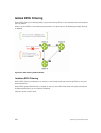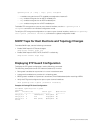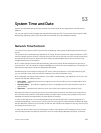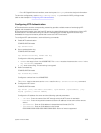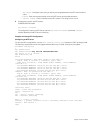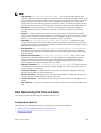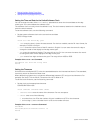53
System Time and Date
System time and date settings and the network time protocol (NTP) are supported on the MXL switch
platform.
You can set system times and dates and maintained through the NTP. They are also set through the Dell
Networking operating system (OS) command line interfaces (CLIs) and hardware settings.
Network Time Protocol
The network time protocol (NTP) synchronizes timekeeping among a set of distributed time servers and
clients.
The protocol also coordinates time distribution in a large, diverse network with various interfaces. In NTP,
servers maintain the time and NTP clients synchronize with a time-serving host. NTP clients choose from
among several NTP servers to determine which offers the best available source of time and the most
reliable transmission of information.
NTP is a fault-tolerant protocol that automatically selects the best of several available time sources to
synchronize to. You can combine multiple candidates to minimize the accumulated error. Temporarily or
permanently insane time sources are detected and avoided.
Dell Networking recommends configuring NTP for the most accurate time. In the Dell Networking OS,
you can configure other time sources (the hardware clock and the software clock).
NTP is designed to produce three products: clock offset, roundtrip delay, and dispersion, all of which are
relative to a selected reference clock.
• Clock offset — represents the amount to adjust the local clock to bring it into correspondence with
the reference clock.
• Roundtrip delay — provides the capability to launch a message to arrive at the reference clock at a
specified time.
• Dispersion — represents the maximum error of the local clock relative to the reference clock.
Because most host time servers synchronize via another peer time server, there are two components in
each of these three products, those determined by the peer relative to the primary reference source of
standard time and those measured by the host relative to the peer.
In order to facilitate error control and management of the subnet itself, each of these components is
maintained separately in the protocol. They provide not only precision measurements of offset and delay,
but also definitive maximum error bounds, so that the user interface can determine not only the time, but
the quality of the time as well.
In what may be the most common client/server model, a client sends an NTP message to one or more
servers and processes the replies as received. The server interchanges addresses and ports, overwrites
System Time and Date
925






